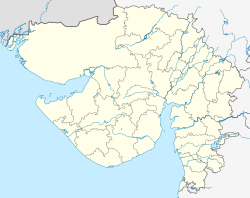Bhuj
city in Gujarat From Wikipedia, the free encyclopedia
Remove ads
Bhuj (![]() pronunciation (help·info)) is a city and the headquarters of Kutch district in the Indian state of Gujarat.
pronunciation (help·info)) is a city and the headquarters of Kutch district in the Indian state of Gujarat.
Remove ads
Etymology
According to legend, the region of Kutch (also called Kachchh) was once ruled by Nāga chieftains. One of the key figures in this story is Queen Sagai of Sheshapattana, who was married to King Bheria Kumar. She led a revolt against Bhujanga, the last Nāga chieftain. In the battle that followed, Bheria was defeated, and Queen Sagai committed sati, the act of self-immolation. The hill where they lived eventually became known as Bhujia Hill, and the town at its base was named Bhuj. Over time, the local people began to worship Bhujanga as a snake god, and a temple was built in his honor.[2]
Remove ads
Geography
Bhuj is located at an average elevation of 110 metres (about 360 feet) above sea level. On the eastern side of the city stands Bhujia Hill, which is topped by Bhujia Fort. This hill acts as a natural divider between Bhuj city and the nearby town of Madhapar, which is known as one of the richest villages in Asia. The city also has two main lakes—Hamirsar Lake and Deshadsar (દેેશળસર)—which add to its charm and are important water sources.
Remove ads
Places of interest
- Prag Mahal
- Aina Mahal
- Sharadbaugh Palace
- Kutch Museum
- Ramkund
- Swaminarayan temple
- Chhatedi of Bhuj
- Hamirsar Lake
- Mahadev Gate near Hamirsar Lake
- Darbargadh Fort
- Bhujia Fort and Smritivan on Bhujia Hill
- Tapakeshwari Devi Temple near Bhuj
- Hill Garden
- The Vande Mataram Memorial is located at Village - Bhujodi near Bhuj
Demographics
In 2011 the population of Bhuj was 213,514, which consisted of 111,146 males and 102,368 females.[1]
Transportation
Bhuj Railway Station - Main Building
19132 Kutch Express at Bhuj railway station
Aircraft at Bhuj Airport
Trains
Remove ads
References
Wikiwand - on
Seamless Wikipedia browsing. On steroids.
Remove ads





















